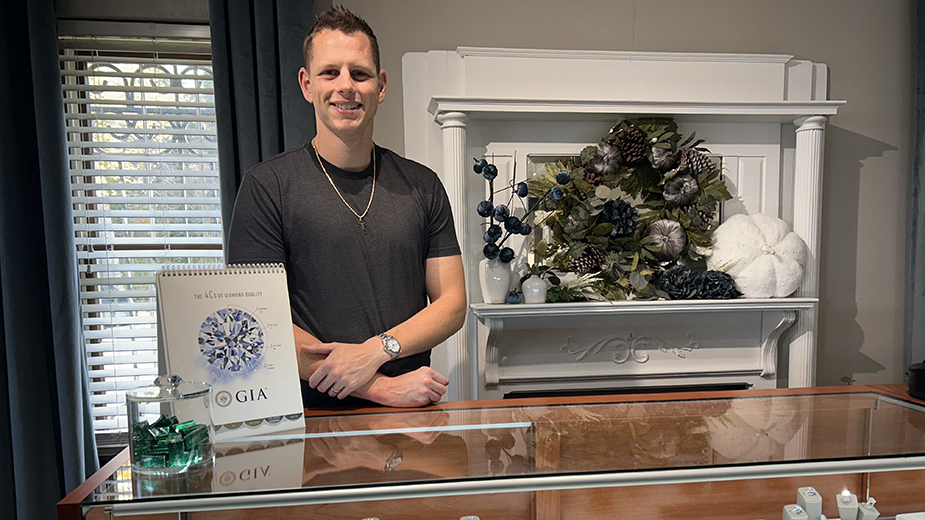YOUNGSTOWN, Ohio – Is there a $150,000 diamond mosaic bracelet or a $39,000 platinum Rolex on your holiday gift list? If so, you can find both items at Thom Duma Fine Jewelry in Warren.
With 30 carats of diamonds in mixed cuts, giving off a brilliant pattern, there are Tacori bracelets at Thom Duma’s fit for any queen. A platinum ring with more than eight total carats of diamonds can be added for $220,000 more.
It could be the best Christmas present ever, albeit a bit pricey for most shoppers this holiday season.
Three local, family-owned jewelers – Thom Duma, Aebischer’s Jewelry in Poland and Komara Jewelers in Canfield – are ready to help customers with a range of budgets find something shiny, beautiful and on trend for the most important people on their shopping list this year.
“We have been blessed in the sense that for us, January through November are all very consistent,” Tom Duma says. “As a business owner you’d rather have consistency, right? But December definitely is double any other month.”
LAB-GROWN DIAMONDS
While quality jewelry can last a lifetime or even generations, lab-grown diamonds allow those with smaller budgets to bring home more bling for less money. Customers who want the look of diamonds without the diamond price tag are finding lab grown to be a great option.

“It’s a diamond. It sparkles like a diamond, wears like a diamond. It’s just made different,” says Brianna Komara, of Komara Jewelry, adding they offer a diamond wall where people can see what they like and what they are comfortable spending.
Duma says his store only carries loose lab diamonds, which can be set into engagement rings for those who want the look of a larger stone without the price tag. A four-carat natural diamond has a price tag of $99,000, while four-carat lab diamond is $8,000.
Customers and their friends might not be able to tell the difference, but Adam Aebischer states a trained jeweler in a testing lab can. If you are buying the jewelry as an investment, he notes a lab grown diamond only has sentimental value after it leaves the store, which may be perfect for one type of wearer and not for another.
“This is a very sentimental chapter of life,” Aebischer says of the wedding proposal, adding for some proposing with something very rare like a diamond is important. “And so half of our customers still love to go the natural route and half like to go the laboratory grown route. I don’t personally see a right or wrong to it. I like to educate and have them make the decision that best suits them.”
Duma says the makers of lab-grown diamonds have refined the process in the last 30 years. They start with a sliver of an uncut actual diamond and grow it under mechanical pressure and heat, mimicking the way diamonds were naturally created for millions of years. In the lab, it takes about 30 days.
Duma says once the technique was perfected, lab-grown diamonds were rare and marketed as being more ethical. Seven years later, supply is high and prices are low. He believes they will continue to drop in value.
SOMETHING DIFFERENT
Aebischer and Komara agree that many customers want to customize wedding rings and bring in designs of something they love.
“The new designs, new bridal designs, that’s been very exciting,” Aebischer says. “The designs are coming straight out of New York and Chicago. Some really wonderful creative minds are designing some beautiful pieces and we offer a large variety here for sure.”
While Aebischer notes brides used to mainly want round stones, which are beautiful, everyone now wants their bridal set to be different, leading to a return of emeralds, marquis and pear-shaped stones.
“That’s what’s been exciting. It’s not always been the same exact style,” says Aebischer, who is a graduate gemologist and a certified stone setter. Aebischers recently added a laser welder, and now do almost all of their stone-setting on site.
During a Christmas in October event, Komara says her store began introducing what is new this holiday season and learning what customers are seeking. She says yellow gold is back in style – earrings, chains and engagement rings. And for those on a tighter budget, gold plating can make the item more affordable with all the glamour of gold.
Colored stones including moonstones and sapphires are trending as well, she says, pointing to pieces from Bellarri, an Italian designer that she finds to be both cool and different.
Marquis-shaped stones are emerging again, she says, noting they have not been popular since the 1980s or 1990s.
Komara says women are buying not just one bracelet but stacking their bracelets and layering their necklaces.
She notes Lafonn offers some luxurious looking pieces without breaking the bank. Among them are pieces that merge sterling silver and gold plating for a high-end look.
“We try to get all different markets,” Komara says. “Being third generation, we still have customers of my grandpa’s that want to shop for their grandchildren and then we have millennials, who want to shop for themselves. We have all types of different customers. So, it’s fun.”
Duma points out sterling silver is currently $32 per ounce, while gold is $2,800, which makes a difference for some.
There is a huge difference of prices for white metals, such as sterling, stainless steel and platinum, which is the purest of all metals.
“But when you have that on your wrist, you know happiness,” Duma says.
Pictured at top: Adam Aebischer says many customers want to customize their wedding rings.
